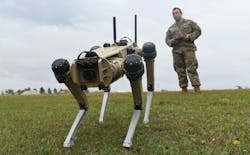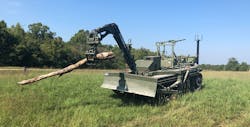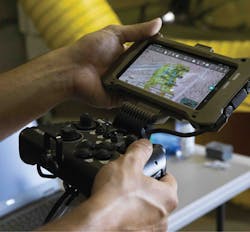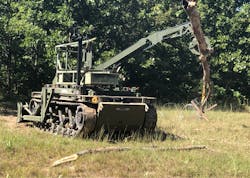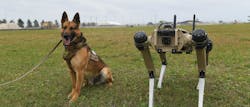Robots ready for the battlefield
By Megan Crouse
NASHUA, N.H. - The Empire Strikes Back concreted Star Wars in the minds of the moviegoing public as a new phenomenon. One of the aspects that caught people’s imaginations so much was the battle on the snow field and the walking tanks used by the evil Empire. Decades later, today’s real-life walker robots have come full circle as the Boston Dynamics machine "Spot" features in the 2022 Star Wars television show The Book of Boba Fett.
In the real world, replicating the agility, balance, and adaptability of an animal’s gait could re-define what terrain vehicles can travel over. They’re also just one aspect of the growing field of unconventional autonomy, from autonomous tanks with treads to conventional wheeled vehicles turned into remote-controlled versions.
Walking robots since the 1960s
Robots with legs have existed in one form or another and fascinated people for decades. General Electric attempted to introduce a “Walking Truck” in the 1960s. The Army was encouraging the effort in this time, too, awarding a study contract for a human-operated machine with 12-foot legs and a 35-mile-per-hour walking speed. In fact, it only ever hit 5 miles per hour and proved onerous to drive. The future, it wasn’t.
The major difference between this and other experiments with walking robots of the past and today’s machines is the physical presence of a pilot. Without fly-by-wire or Wi-Fi capabilities, older models were intended to bring humans along for the ride to transport equipment or wounded people.
Today, robots with two legs or four that can operate on their own are a lucrative experiment for industrial work as well as the military.
Some companies and academic groups are combining walkers with wheels, or experimenting with two-legged robots, for industrial settings instead. The ETH Zurich Robotic Systems Lab has added wheels to a dog-like mobile platform, which they advertise as working in smart freight logistics systems. The wheels enable it to traverse terrain including stairs, and the company claims it can carry more weight than a lightweight delivery drone suitable for the same purpose.
Rescue and cargo remain the primary use for military robots today. Robotic vehicles increase combat effectiveness in “dumb, dirty, or dangerous” situations in particular, says Tim Reese, director of U.S. business development at General Dynamics Land Systems in Sterling Heights, Mich. ‘Dumb’ missions may be tedious, tiresome, or prohibitively boring for a human. ‘Dirty’ missions may involve chemical contaminants or the threat of disease, while ‘dangerous’ missions bring people onto contested ground where they or their vehicles are likely to come under fire.
When is a tank not a tank?
Tracked unmanned vehicles are undergoing their own technological changes at the same time as legged ones. General Dynamics Land Systems is competing for four U.S. Army initiatives today. Company officials say military customers are looking for the best way to navigate difficult terrain. Is the best way really adding legs to your vehicle? Integrating autonomy into treaded vehicles means a tank can be more than a tank — it becomes a robot.
“One of the largest challenges we’ve faced in our domain is terrain,” says Bill Tecos, technology fellow for advanced capabilities at General Dynamics Land Systems. “You have to be able to more accurately perceive what you’re able to maneuver through. That can depend on terrain segments or what we call terrain portions. That might [mean] the associated grade of the terrain that the associated vehicle can traverse. That may come down to: is that a flat surface or is it water?”
General Dynamics Land System’s most remarkable project in this area is the medium-class combat vehicle known as the Tracked Robot 10-Ton, or TRX, built on technologies proven with the Army’s Small Multipurpose Equipment Transport (SMET) robotic vehicle program. It’s part of the company’s competition entries for the Army’s Robotic Combat Vehicle Program of Learning program. They’re also contributing vehicles in three different size classes as well as the Katalyst open architecture, which includes added mobility, lethality, and survivability functions.
Not all uncrewed vehicles of this ilk are technically autonomous. For example, General Dynamics Land System’s small Multi-Utility Tactical Transport (MUTT) accepted for the Army’s Small Multipurpose Equipment Transport (S-MET) program, has a means of control called the dismount following tether. This is “a Kevlar line connected to sensors on the vehicle that a soldier connects to his or her equipment on their person,” says Ray Moldovan, manager of U.S. business development at General Dynamics. “Based on the soldier’s movement, the system shadows the soldier.”
Similar vehicles may have low-powered remote control and cameras that relay imagery to an operator at a remote location.
For now, TRX hosts U.S. government-owned autonomy software, Moldovan explains, which enables it to do basic tasks like waypoint navigation. The TRX Next Generation Electronic Architecture also will be used eventually for this, as for the other vehicles of this line.
Software development
The speed of software development has had a big impact on projects like these, says Tecos.
“Technology has been going at a very quick clip, and when you look at this evolution, it’s predicated on iterative-type development,” says Tecos. “Very quick software cycles, being able to demonstrate things in a digital environment. Although some of the different sensor types have been out for a while, newer sensors have emerged, and lidar is commonly used. You have to look at the combination. How they’re integrated, when they’re powered on and off has an impact on the mission.”
Military use opens the machinery up to situations industrial machines probably won’t face. “For example, anything that emits power is going to compromise your mission, which means you’re more susceptible to detection by an adversary — as opposed to cameras, that don’t do that,” says Tecos.
So, the algorithms General Dynamics vehicles need must be able to adapt to “degraded” states they might encounter in a dangerous situation, Tecos says.
The industrywide acceleration of changes and improvements in software affects development of this type of vehicle in a major way. Customers in the military electronics industry are asking for designs to be more modular more often than they did one or five years ago, Tecos says.
“That doesn’t mean a huge tech disparity between then and now. However, modular designs are essential now because the ability to adapt and augment quickly, both from software and hardware perspectives, are key,” Tecos says. “That’s because technology is moving so fast. If it’s taking a long time to implement these technologies, that’s going to have an impact on your customer.”
Artificial intelligence
Artificial intelligence (AI) and machine learning also are a big part of developments, and are having a profound impact on this area.
“Obviously, it’s new, but its applicability across all aspects of engineering are very large,” Tecos says. “In our domain its contributions to situation awareness and lethality are continuing to grow at quick paces.”
He also points out that advancements in sensor technologies — namely the ability to detect, monitor and better understand an environment —is an area in which companies are competing to give military customers an advantage.
“Software’s going to be a key advantage here. Its evolution and new emerging potential are going to be critical. How those can be evaluated and eventually tested on or off platform will be huge contributors.”
Reese of General Dynamics points out that with increased emphasis on software, increased emphasis on cyber security has to go hand-in-hand.
“Cyber obviously is a very important aspect to this,” he says. “It’s not necessarily just running your virus protection, but things about authentication, root and trust, being able to protect your data on the move as well as at rest.”
Another emerging technology that he sees as a strong enabler that will have a larger footprint in the future is Time Sensitive Networking (TSN), a set of standards currently under development in the IEEE 802.1 working group. Customers also are advocating for modular design and open approaches, Reese adds.
All-terrain wheeled mules
With General Dynamics Land Systems autonomous tanks in the testing phase, Reese notes that not all situations call for a walker.
“You can imagine a scenario where only a quadruped could get up or through a piece of terrain, because it’s restricted by trees or steep rock or whatever and that dog-type system would be right to carry gear,” he says. However, “Most of the scenarios the Army is looking to use robots in don’t need that. They need vehicles to carry more gear … sensors that can operate away from human beings, and operate away from humans but part of a team.”
What do autonomous trucks for the military look like today? While low levels of autonomy and lane keeping enter the consumer car market, it’s been a bit harder to adopt the same to off-road operation or contested territory.
Unmanned ground vehicles (UGVs) have been a staple in the industry for a decade. DARPA sponsored a competition for autonomous vehicles in 2004. In 2013, IEEE posted an article about Lockheed Martin looking for commercial applications for technology developed for MULE, a six-wheeled unmanned vehicle remotely operated using a modified video game controller. This MULE never went into service, and indeed was considered a death knell for the Army’s robot-heavy modernization program at the time. However, there’s still enough momentum around the concept of an autonomous truck for it to be in conversation today.
The new ideal version connects to the Army’s Multi-Domain Operations strategy and adds artificial intelligence to the mix. In turns of purpose, they’re still trying to do the same thing that original DARPA challenge was — to avoid exposing soldiers to improvised explosive devices (IEDs). Other vehicles might be part of manned-unmanned teaming, which is in the field today in the form of drones operating alongside conventional aircraft. This is the direction the Army is pursuing today in regards to putting autonomous vehicles in combat situations.
They’re also looking for trucks that can compensate when humans “may find it challenging to maintain a high level of alertness if they’re driving a combat vehicle across unfamiliar or dangerous terrain,” says an Army announcement regarding the 2020 Artificial Intelligence for Maneuver and Mobility, or AIMM, Essential Research Program. Will today’s software capabilities, from more informed navigational tools to Natural Language Processing controls, be key to the battlefields of tomorrow? Or is this kind of autonomy doomed to remain impractical for a matter of decades?
Dogs and other walkers
Likely the most popularly known company in the field of autonomous walking robots is Boston Dynamics of Waltham, Mass., which failed to secure a permanent military posting with their ‘mule’ vehicle. However, the company is still a good look at which enabling technologies in this area are truly practical and mass producible. Today, Boston Dynamics focuses on industrial and service uses for their four-legged robots. Their robots are still agile and smart, and show a possible parallel path for walking autonomous robots in the commercial space.
The problem with using them for the military? Too loud. That was the verdict of the 2015 experiments with the Legged Squad Support System or LS3, the Marine Corps Warfighting Lab successor to the Boston Dynamics Big Dog (developed with funding from DARPA and the Army Research Laboratory’s RCTA program).
Instead, the company shifted to its smaller Spot robots for industrial use. The newest model, Spot 3.0, boasts flexible autonomy, repeatable data capture, integration with computer vision models, and an expanded Autowalk, the feature that allows operators to program in autonomous missions using dynamic sensing wherever the robot may go.
As far as software, Spot 3.0 enables connection with AWS, Azure, IBM Maximo, and other systems.
A Boston Dynamics spokesperson told Military & Aerospace Electronics that they see legged robots as “coming of age” today. “Quadrupeds are leaving the lab and entering the workplace, and the ongoing labor shortages plaguing many industries has only intensified the need. This year, customers will begin deploying mobile robots like Spot at greater scale across their enterprises.”
They also question how many projects in this area are practical. “But for industrial mobile robots to expand rapidly at enterprise scale, we also need to see greater reliability from the industry as a whole. We’ve seen a lot of products announced that are conceptual-only or that have only been deployed in small proof-of-concept exercises. As more and more businesses look to invest in real-world technology, the most reliable, robust and accessible products will prevail.”
Weaponized robots
Meanwhile, Ghost Robotics in Philadelphia creates models of a similar size and appearance for military customers. While Boston Dynamics specifies it will not sell weaponized robots, Ghost Robotics has leaned in the opposite direction. Its flagship Quadrupedal Unmanned Ground Vehicle product is the Vision 60, implemented in 2021 as part of a Virtual Security Operations Center project at Tyndall Air Force Base in Florida. Ghost Robotics’ dogs were implemented into existing patrol routes, and were semi-autonomous. An operator looked through the dog’s ‘eyes’ using Immersive Wisdom’s 3D Virtual Ops Center, software designed to provide greater security through use of a virtual reality environment.
“The major selling point of this technology is that it’s meant to be expendable, whereas our Airmen are not,” said Master Sgt. Justin Hanlon, 375th Security Forces Squadron operations noncommissioned officer in charge at Tyndall, in a 2020 press release.
“Instead of using a human being as a sentry, imagine a mobile sensor with a high-definition, wide-angle camera and long-range capabilities being controlled by a trained Airman from the safety and security of a Base Defense Operations Center or a Theatre Operations Center in both a garrison or contested environment,” said Hanlon.
Tyndall Air Force Base was chosen as a testbed for technologies like this in part because of ongoing construction after a hurricane struck it in 2018. This means that the Airmen stationed there could use robotic help and that the reconstruction can take future technology into account. However, that also means these units are still considered experimental, and may or may not make a mark on the military more widely. A Ghost Robotics canine with a weapons system attached was revealed as recently as the Association of the United States Army’s 2021 annual conference, but hasn’t been publicly tested in the field, and would likely start out as the kind of semi-autonomous functionality being tested at Tyndall.
As well as advertising the quadrupedal form factor’s ability to get up after a fall and/or abrupt change in terrain, they’re also banking on the blind-mode operations that give it the semi-autonomy Tyndall was interested in.
Ghost Robotics founder and CEO Jiren Parikh says the animal inspiration for their robots goes as far as feet that can “feel by minute forces that are generated through current changes in the motors.” Redundant sensors and this “blind mode” — the ability for the robot to sense its surroundings without sensors in the feet — set it apart, Parikh says.
Vision 60 runs on an NVIDIA Xavier AI GPU with open architecture, and Ghost Robotics notes that along with the differences in leg sensor functionality, their focus on software also sets them apart. The legs operate on “software springs” for more accurate control.
Meanwhile, Boston Dynamics is expanding into more custom robots for industrial use, diversifying from the photogenic ‘dogs.’ Their representative says they expect to see more walking vehicles as part of ‘robot-as-a-service’ models in the future.
“We welcome competition, as it validates the market potential of mobile robotic technology. We are encouraged that so many others are now beginning to see the value of mobile robots.”
